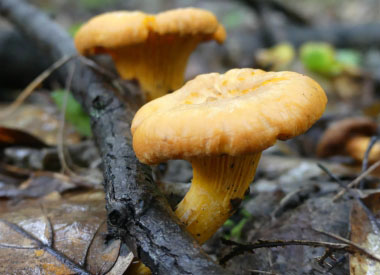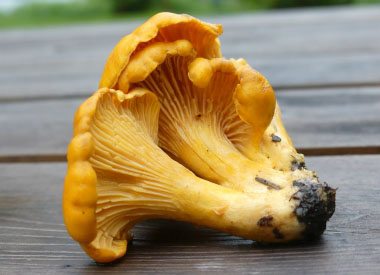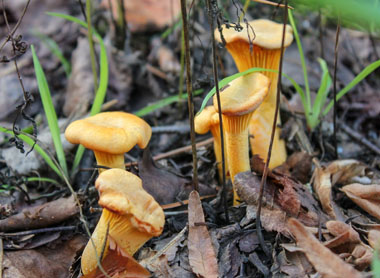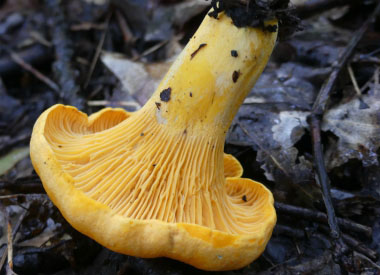





Do not eat any fungi that has not been properly identified by a qualified professional, some are DEADLY when ingested. All edible wild fungi MUST be cooked.
Cantharellus cibarius is widely viewed as among the most desirable of edible mushrooms. They can be found singly, scattered, in groups, or sometimes clustered on the ground in woods. Its flesh is thick, firm, and is has a scent that is somewhat apricot-like. This variety of chanterelles are one of the most popular and prolific wild mushrooms. There are well over forty chanterelle varieties across North America. While it can be difficult to distinguish between the varieties, generally, chanterelles are very easy to identify.
Type
Distinguishing Features
The chanterelle usually has a funnel-shaped cap with a diameter up to 10 cm. It has a wavy irregular margin. Colour varies from light yellow to deep egg-yolk yellow. When growing in clumps, as is often the case, the stipes are often curved and occasionally joined together near the base. The veins are very thick and decurrent, extending well down the stem; they are straight near to the stem but forked and more sinuous towards the edge of the cap.
Height
6 to 9 cm on average.
Habitat
Chanterelles are most frequently found in deciduous forest soils near oak. They often occur under beech trees as well. They are mycorrhizal, which means the fungus has a symbiotic, mutualistic association with the roots of the tree. Chanterelles grow in many countries. The can be found across Canada, the U.S., Europe, the Mediterranean, parts of eastern and southern Australia, and parts of Asia.
Spore Print
Pale yellow to creamy white, sometimes with a slight pinkish tinge.
Season
June to October is when you'll find these and even into November during mild autumns. Often they occur from October right through to the following March in warmer climates.
Gills
The gills are ridges that are forked and generally have blunt edges that are the same colour as the rest of the mushroom. They are often quite wavy and always decurrent.
Edibility
They have a faint apricot-like scent; and a mild taste. Chanterelles are a choice edible mushroom. They can be used in risotto dishes and omelettes, and they certainly has enough flavour to make tasty soups or sauces.
Other Name
Common Chanterelle.
Recipes
To support our efforts please browse our store (books with medicinal info, etc.).
Winter Survival Food Handbook

PDF Plant Magazines
Types of Wild Food
Geographic Zones Seasons
Disclaimer
EdibleWildFood.com is informational in nature. While we strive to be 100% accurate, it is solely up to the reader to ensure proper plant identification. Some wild plants are poisonous or can have serious adverse health effects.
We are not health professionals, medical doctors, nor are we nutritionists. It is up to the reader to verify nutritional information and health benefits with qualified professionals for all edible plants listed in this web site. Please click here for more information.
Why Edible Wild Food?
- Food costs are rising
- Free, wild food is readily abundant
- Wild food adds nutrition to your diet
- Wild food can help treat various medical conditions





